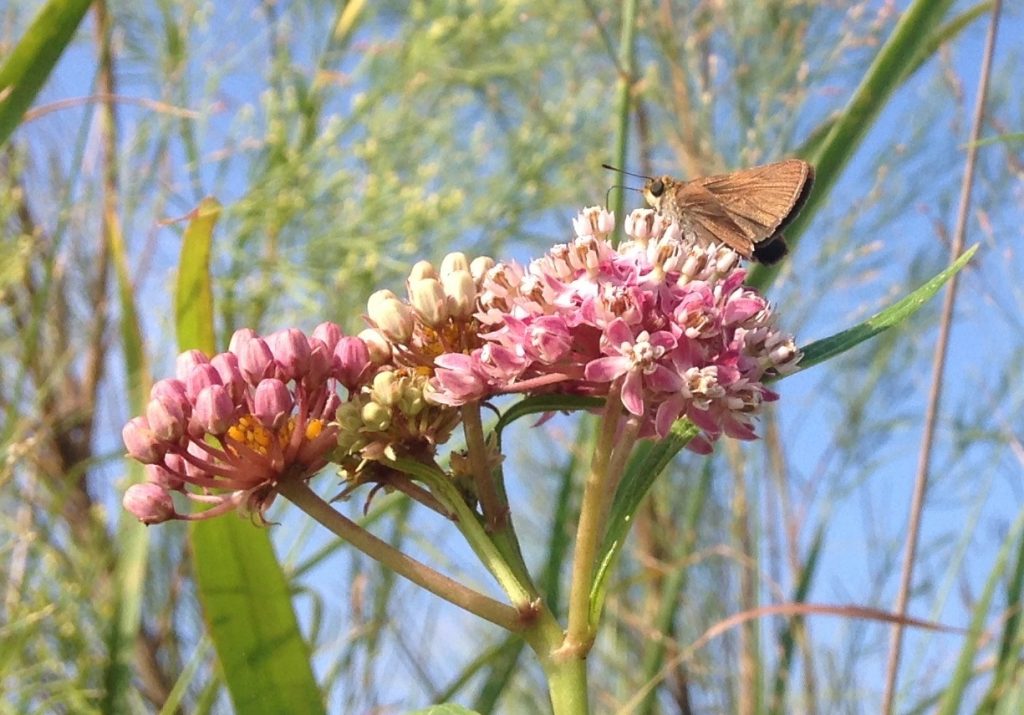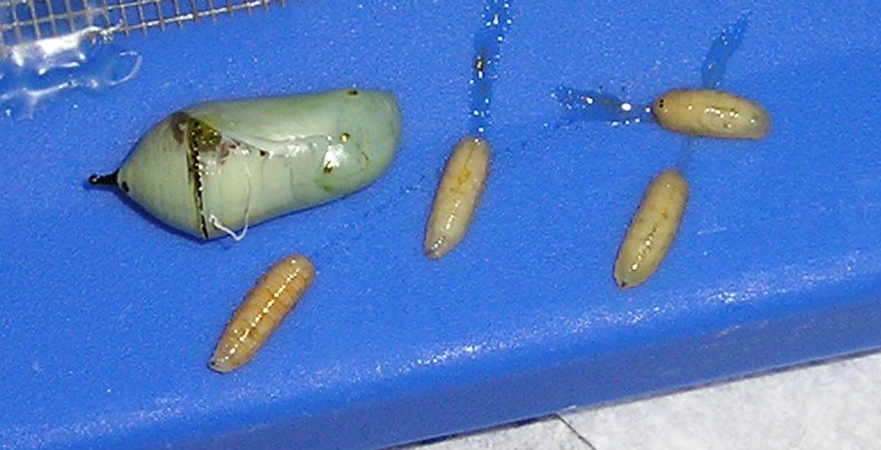Pollinator week is here (June 16 – 22), the Summer Solstice arrives this Saturday and Dr. Chip Taylor of Monarch Watch is bullish on Monarchs this season.
Taylor has been updating the DPLEX list of late with positive, upbeat messages suggesting that this year’s Monarch crop may be slightly larger than last year’s record low. That would be heartening.

Skippers and other pollinators enjoyed the Swamp milkweed last weekend on the Llano. No Monarchs. Yet. Photo by Monika Maeckle
“There will be a modest increase in Monarch numbers and most of that will come from the upper midwest,” Dr. Taylor wrote via email when asked to explain.
For those unaware, the D-PLEX list, named after the Monarch butterfly’s Latin designation, Danaus plexipus, is an old-fashioned email listserv started by Taylor that reaches hundreds of butterfly enthusiasts and scientists. Sign up to receive D-PLEX emails on the Monarch Watch webpage.
Taylor bases his predictions on past history, warmer temperatures this spring and a late summer. Also, this year’s tough winter has obliterated the usual natural predators to

Tachinid flies lay their eggs on Monarch caterpillars, using them as a host. Taylor says they are not as pervasive this year as in years past. Photo via University of Georgia Athens
Monarch larvae–the tachinid flies, wasps, spiders and other death threats that couple with climate change, habitat loss, genetically modified crops and insecticide use to pose a grave threat to the continuation of the Monarch butterfly migration.
Here’s what Dr. Taylor wrote on June 15:
The harsh winter may account in part for the lack of predators but the last three dry summers may have driven local predator populations down as well…. The tachinid flies also seem to be down….
Whatever the cause, or causes, of these low numbers of predators and parasites, Monarch larvae should survive in greater numbers. Elevated reproductive success in early generations usually leads to growth of the population.
We’ll take it.
The Solstice occurs this Saturday, June 21 at 5:51 AM CDT marking the astronomical moment when the sun reaches its northernmost point in the sky, resulting in the longest day of the year. From here til December, the days will get shorter. Monarch butterflies use the sun compass in their antennae to pick up on these solar cues and by late August they’ll start heading south on their journey to Mexico to roost for the winter. Won’t be long now.
Keep an eye out for those that respond to the sun’s signals and your fingers crossed that Dr. Taylor’s optimistic predictions are correct.
Related posts:
- Plant Flowers, Sign the Petition for Pollinator Week June 16 – 22
- First Lady Michelle Obama Plants First Ever Pollinator Garden at the White House
- Monarch Butterfly Numbers Plummet: will Migration become Extinct?
- NAFTA Leaders, Monsanto: Let’s Save the Monarch Butterfly Migration
- What does climate change mean for Monarch butterflies?
- Monarch butterflies: the Panda Bears of Climate Change
- Persnickety Texas Native Milkweeds Pose Challenges for Growers
- Texas Butterfly Ranch Native Texas Milkweed Guide
- A Year in the Life of a Mostly Native Urban Butterfly Garden
Like what you’re reading? Follow butterfly and native plant news at the Texas Butterfly Ranch. Sign up for email delivery, like us on Facebook, or follow us on Twitter, @monikam.


The milkweed seeds we have haven’t seemed to need stratifying. Seeds sprout very soon. It would be nice to hear how to follow up growing the seedlings. They were started in potting soil, but when moved up to large, tall 6-pks 1/3 caleche was added to their soil mix. The fattening of the upper root probably shows early tuber development. I would like to have several dozen plants in Junction, some in my street front native plant “patch”, some for the landscaping at the school.
HI Betty, it depends on what kind of milkweed it is. If it’s the Tropical or incarnate (Swamp milkweed) it seems they will take off on their own. Keep planting. And thanks for sharing.
MOnika
I live in central Ohio. I have 1.5 acres, 30 minute drive from Columbus airport. Semi rural area… have not seen a monarch in two years. Y property is heavily planted with oldfield and prairie nectar plants and three species of milkweeds. I donated almost two pounds of common milkweed seed to the 10,000 acre zoo park, The Wilds, last fall. I’m feeling blue with no sightings in two years… :'(
Bummer, Kit. I feel your pain. We haven’t had a lot of action here in San Antonio, either this year. Keeping fingers crossed for the fall.
–Monika
I have giant and red milkweed, lots of other butterflies so far, but no Monarchs. I also have another milkweed that grows about 4′, has several branches and clusters of small white flowers, do not know the name. Its pods are long (5″) , very slender. I have saved seed so I can plant them out of the reach of the road crew when they mow, doing same with all other butterfly plants.
QUESTION: DO YOU HAVE mONARCHS i CAN BUY AND HATCH SO i MIGHT HAVE SOME TO RETURN HERE NEXT YEAR?
Dorlis, I think the tall branched “milkweed” you are describing is actually hemp dogbane, which has a milky sap but is not the kind of milkweed Monarchs use. It’s seed pods do resemble those of milkweed. Here in the Ozarks it is an invasive, but native plant. I battle it all the time.
Dorlis,
I don’t sell butterflies–yet. Maybe some day. Check out the International Butterfly Breeders Association website and find a breeder near your home. Here’s the website: http://www.butterflybreeders.org. Thanks for writing.
I live in Morgantown, WV, and have been lucky enough to see a few Monarch caterpillars and adults last year, and have spotted several caterpillars eating milkweed this June, 2014. The milkweed is in a community garden that we are going to have certified as a Monarch way station.